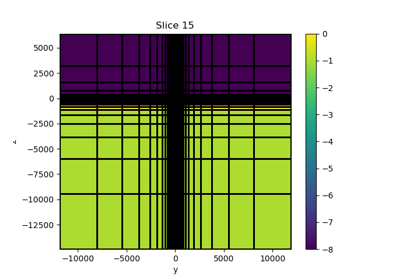simpeg.electromagnetics.natural_source.receivers.Tipper#
- class simpeg.electromagnetics.natural_source.receivers.Tipper(locations_h, locations_base=None, orientation='xx', component='real', storeProjections=False)[source]#
Bases:
BaseNaturalSourceRxReceiver class for tipper data (3D problems only).
This class can be used to simulate AFMag tipper data, defined according to:
\[\begin{split}\begin{bmatrix} T_{zx} & T_{zy} \end{bmatrix} = \begin{bmatrix} H_x^{(x)} & H_y^{(x)} \\ H_x^{(y)} & H_y^{(y)} \end{bmatrix}^{-1} \, \begin{bmatrix} H_z^{(x)} \\ H_z^{(y)} \end{bmatrix}\end{split}\]where superscripts \((x)\) and \((y)\) denote signals corresponding to incident planewaves whose electric fields are polarized along the x and y-directions respectively. Note that in
simpeg, natural source EM data are defined according to standard xyz coordinates; i.e. (x,y,z) is (Easting, Northing, Z +ve up).The receiver class can also be used to simulate a diverse set of Tipper-like data types when horizontal magnetic fields are measured at a remote base station. These are defined according to:
\[\begin{split}\begin{bmatrix} T_{xx} & T_{yx} & T_{zx} \\ T_{xy} & T_{yy} & T_{zy} \end{bmatrix} = \begin{bmatrix} H_x^{(x)} & H_y^{(x)} \\ H_x^{(y)} & H_y^{(y)} \end{bmatrix}_b^{-1} \, \begin{bmatrix} H_x^{(x)} & H_y^{(x)} & H_z^{(x)} \\ H_x^{(y)} & H_y^{(y)} & H_z^{(y)} \end{bmatrix}_r\end{split}\]where subscript \(b\) denotes the base station location and subscript \(r\) denotes the mobile receiver location.
- Parameters:
- locations_h(
n_loc,n_dim) array_like Locations where the roving magnetic fields are measured.
- locations_base(
n_loc,n_dim) array_like,optional Locations where the base station magnetic fields are measured. Defaults to the same locations as the roving magnetic fields measurements, locations_r.
- orientation{‘xx’, ‘yx’, ‘zx’, ‘zy’, ‘yy’, ‘zy’}
Specifies the tipper element \(T_{ij}\) corresponding to the data.
- component{‘real’, ‘imag’, ‘complex’}
Tipper data type. For the tipper element \(T_{ij}\) specified by the orientation input argument, the receiver can be set to compute the following: - ‘real’: Real component of the tipper (unitless) - ‘imag’: Imaginary component of the tipper (unitless) - ‘complex’: The complex tipper is returned. Do not use for inversion!
- storeProjectionsbool
Whether to cache to internal projection matrices.
- locations_h(
Attributes
Tipper data type; i.e. "real", "imag".
Locations of the two field measurements.
Base station magnetic field measurement locations.
Roving magnetic field measurement locations.
Number of data associated with the receiver object.
Specifies the tipper element \(T_{ij}\) corresponding to the data.
Universal unique identifier
Methods

